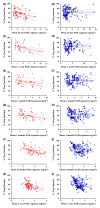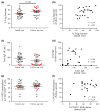Childhood exposure to ambient polycyclic aromatic hydrocarbons is linked to epigenetic modifications and impaired systemic immunity in T cells
- PMID: 25048800
- PMCID: PMC4396982
- DOI: 10.1111/cea.12377
Childhood exposure to ambient polycyclic aromatic hydrocarbons is linked to epigenetic modifications and impaired systemic immunity in T cells
Abstract
Background: Evidence suggests that exposure to polycyclic aromatic hydrocarbons (PAHs) increases atopy; it is unclear how PAH exposure is linked to increased severity of atopic diseases.
Objective: We hypothesized that ambient PAH exposure is linked to impairment of immunity in atopic children (defined as children with asthma and/or allergic rhinitis) from Fresno, California, an area with elevated ambient PAHs.
Methods: We recruited 256 subjects from Fresno, CA. Ambient PAH concentrations (ng/m(3) ) were measured using a spatial-temporal regression model over multiple time periods. Asthma diagnosis was determined by current NHLBI criteria. Phenotyping and functional immune measurements were performed from isolated cells. For epigenetic measurements, DNA was isolated and pyrosequenced.
Results: We show that higher average PAH exposure was significantly associated with impaired Treg function and increased methylation in the forkhead box protein 3 (FOXP3) locus (P < 0.05), conditional on atopic status. These epigenetic modifications were significantly linked to differential protein expression of FOXP3 (P < 0.001). Methylation was associated with cellular functional changes, specifically Treg dysfunction, and an increase in total plasma IgE levels. Protein expression of IL-10 decreased and IFN-γ increased as the extent of PAH exposure increased. The strength of the associations generally increased as the time window for average PAH exposure increased from 24 hr to 1 year, suggesting more of a chronic response. Significant associations with chronic PAH exposure and immune outcomes were also observed in subjects with allergic rhinitis.
Conclusions and clinical relevance: Collectively, these results demonstrate that increased ambient PAH exposure is associated with impaired systemic immunity and epigenetic modifications in a key locus involved in atopy: FOXP3, with a higher impact on atopic children. The results suggest that increased atopic clinical symptoms in children could be linked to increased PAH exposure in air pollution.
Keywords: FOXP3; IFN-γ; T regulatory cells; Treg function; epigenetics; polycyclic aromatic hydrocarbons; total IgE.
© 2014 John Wiley & Sons Ltd.
Conflict of interest statement
The authors declare that they have no competing interests.
Figures





Comment in
-
Does air pollution really cause allergy?Clin Exp Allergy. 2015 Jan;45(1):3-5. doi: 10.1111/cea.12414. Clin Exp Allergy. 2015. PMID: 25546588 No abstract available.
References
-
- Gupta RS, Springston EE, Warrier MR, et al. The prevalence, severity, and distribution of childhood food allergy in the United States. Pediatrics. 2011;128:e9–17. - PubMed
-
- Moorman JE, Akinbami LJ, Bailey CM, et al. National surveillance of asthma: United States, 2001–2010. Vital Health Stat. 2012;3(35):1–67. - PubMed
-
- Perez L, Declercq C, Iniguez C, et al. Chronic burden of near-roadway traffic pollution in 10 European cities (APHEKOM network) Eur Respir J. 2013;42:594–605. - PubMed
-
- Morgenstern V, Zutavern A, Cyrys J, et al. Atopic diseases, allergic sensitization, and exposure to traffic-related air pollution in children. Am J Respir Crit Care Med. 2008;177:1331–7. - PubMed
Publication types
MeSH terms
Substances
Grants and funding
LinkOut - more resources
Full Text Sources
Other Literature Sources
Medical

